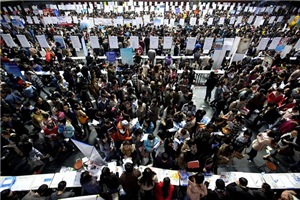
China's economic policy makers have trained their sights on the twin goals of growth and employment, insisting that growth needs to be near current levels to create enough new jobs.
中國(guó)經(jīng)濟(jì)決策者專注于增長(zhǎng)和就業(yè)的雙重目標(biāo),堅(jiān)信經(jīng)濟(jì)增長(zhǎng)需要接近當(dāng)前水平才能創(chuàng)造足夠多的新工作崗位。
The government wants to create 10 million urban jobs and keep the official urban employment rate under 4.6%. Doing so, they believe, is key to ensuring social stability.
中國(guó)政府希望創(chuàng)造1,000萬(wàn)個(gè)城鎮(zhèn)就業(yè)崗位,使官方城鎮(zhèn)失業(yè)率保持在4.6%以下。他們相信這是確保社會(huì)穩(wěn)定的關(guān)鍵。
But many economists say that the official reasoning is flawed and that China could withstand lower growth levels than the 2014 target of about 7.5% and still get all the jobs it needs to meet targets.
但很多經(jīng)濟(jì)學(xué)家表示,官方給出的邏輯存在缺陷,中國(guó)可以承受比2014年7.5%左右的增長(zhǎng)目標(biāo)更低的增速,同時(shí)仍能創(chuàng)造足夠多的就業(yè)崗位。
'The relation between GDP and jobs is not that clear,' said Shen Minggao, head of China research with Citigroup. 'Maybe if growth slows to 6% jobs would still be OK.'
花旗集團(tuán)(Citigroup)中國(guó)研究部負(fù)責(zé)人沈明高表示,國(guó)內(nèi)生產(chǎn)總值(GDP)與就業(yè)之間的關(guān)系并不是那么明確。他指出,也許經(jīng)濟(jì)增速放緩至6%,就業(yè)狀況仍然沒(méi)問(wèn)題。
The official growth target - often referred to as a 'bottom line' for government leaders - is a sensitive issue. For years, planners set a target of 8% even when actual growth breezed past that level - which was more of an acceptable minimum.
官方的經(jīng)濟(jì)增長(zhǎng)目標(biāo)(常常被稱為政府領(lǐng)導(dǎo)人的底線)是一個(gè)敏感問(wèn)題。多年來(lái),”保八”一直是中國(guó)政府設(shè)定的目標(biāo),即便實(shí)際增速遠(yuǎn)超出這個(gè)水平――8%的增長(zhǎng)目標(biāo)作為底線的意義更大一些。
Growth has been slowing more recently, reflecting sluggish global demand and problems at home - not to mention the economy now needs to expand from a much bigger base.
近期中國(guó)經(jīng)濟(jì)放緩幅度擴(kuò)大,暴露出全球需求疲軟和國(guó)內(nèi)存在的各種問(wèn)題,更不用說(shuō)中國(guó)經(jīng)濟(jì)目前的比較基數(shù)比從前大得多。
But the job situation has remained stable. The official unemployment rate is well within the government's broad boundaries - at 4.08% in the first quarter, up marginally from 4.05% at the end of last year.
然而中國(guó)的就業(yè)形勢(shì)卻依然穩(wěn)定。官方公布的失業(yè)率仍在政府設(shè)定的大致范圍內(nèi),第一季度為4.08%,僅略高于去年年底的4.05%。
Employment data so far this year show considerable elasticity in the job market. The first quarter jobs survey released by the Ministry of Human Resources and Social Security showed 111 jobs for every 100 people seeking employment and that the job vacancy level had actually increased over the previous quarter.
今年以來(lái),就業(yè)數(shù)據(jù)顯示勞動(dòng)力市場(chǎng)有相當(dāng)大的彈性。人力資源和社會(huì)保障部公布的第一季度就業(yè)調(diào)查顯示,每100名求職者對(duì)應(yīng)著111個(gè)空缺崗位,崗位空缺水平實(shí)際上較前一季度上升。
The unofficial 'survey' unemployment rate - which unlike the official figure also covers joblessness among migrant workers who comprise the bulk of the labor force - was a still tolerable 5.17% in March.
3月份非官方調(diào)查的失業(yè)率為5.17%,處于可以接受范圍。與官方數(shù)據(jù)不同的是,非官方數(shù)據(jù)囊括了在勞動(dòng)力中占一大部分的農(nóng)民工的就業(yè)情況。
Growth of jobs has eased due to the slowing economic expansion. But demand for labor has remained resilient across much of the economy - from manufacturing and retail, as well as transport, construction and computer services.
由于經(jīng)濟(jì)擴(kuò)張放慢,就業(yè)增長(zhǎng)也趨緩。但從制造業(yè)到零售業(yè)、再到交通運(yùn)輸、建筑和電腦服務(wù)業(yè),中國(guó)大部分經(jīng)濟(jì)領(lǐng)域的勞動(dòng)力需求仍保持彈性。
Combine that with China's aging population - which has meant a decline in the ranks of the nation's working age people (down 2.4 million last year to 920 million) - - and the nation's leaders have a cushion when it comes to unemployment levels.
這種情況再加上中國(guó)的老齡化狀況,令中國(guó)領(lǐng)導(dǎo)人在失業(yè)率問(wèn)題上有了緩沖余地。老齡化意味著中國(guó)勞動(dòng)年齡人口數(shù)量下滑(去年減少了240萬(wàn)人,至9.2億人)。
Whether China has wiggle room to allow lower growth without sparking higher unemployment is crucial. Many economists hoped China would set a lower target for this year, sacrificing some short-term expansion in an effort to make longer term economic adjustments. They argue the current credit-fueled growth model cannot be sustained over the longer term.
中國(guó)在允許經(jīng)濟(jì)增長(zhǎng)放緩但不推高失業(yè)率方面是否有回旋余地至關(guān)重要。很多經(jīng)濟(jì)學(xué)家此前希望中國(guó)將今年的經(jīng)濟(jì)增長(zhǎng)目標(biāo)設(shè)定在較低水平,犧牲一些短期經(jīng)濟(jì)擴(kuò)張,借此完成較長(zhǎng)期的經(jīng)濟(jì)調(diào)整。他們認(rèn)為,當(dāng)前由信貸驅(qū)動(dòng)的經(jīng)濟(jì)增長(zhǎng)模式無(wú)法長(zhǎng)期持續(xù)。
China's leaders have acknowledged the need for new growth drivers and have said they want to make consumption a bigger factor, while reducing the reliance on investment and exports over the longer term.
中國(guó)領(lǐng)導(dǎo)人已經(jīng)承認(rèn)需要新的經(jīng)濟(jì)增長(zhǎng)推動(dòng)力,并稱他們希望在長(zhǎng)期內(nèi)提高消費(fèi)的貢獻(xiàn)力量,同時(shí)降低經(jīng)濟(jì)對(duì)投資和出口的依賴。
A structural overhaul will mean job losses in some parts of the state sector - from big employers like the resource sector to clearly non-strategic companies that don't want to see more competition from private interests.
結(jié)構(gòu)性調(diào)整將意味著國(guó)有經(jīng)濟(jì)領(lǐng)域中一些部分的工作崗位將會(huì)減少,從能源領(lǐng)域等大雇主到不希望面臨私有領(lǐng)域更多競(jìng)爭(zhēng)的非戰(zhàn)略公司都是如此。
That may prove politically difficult. But low unemployment gives policy makers more room to act.
這在政治上可能很難。但低失業(yè)率讓決策者有更多的行動(dòng)空間。
'It's been obvious for a few years that the old idea that 8% growth was necessary to keep unemployment at bay is now completely wrong, if indeed it was ever right,' said Andrew Batson, China research director at Gavekal Dragonomics, a research firm.
研究公司龍洲經(jīng)訊(Gavekal Dragonomics)的中國(guó)研究主管白安儒(Andrew Batson)說(shuō),幾年來(lái)的情況表明,以往那種必須將經(jīng)濟(jì)增幅保持在8%以控制失業(yè)的看法現(xiàn)在完全是錯(cuò)誤的,即便以前這種看法可能曾經(jīng)正確過(guò)。
'The question is how much more growth would have to slow for a real problem to emerge in the job market, and honestly no one knows the answer to this. Since China hasn't had sustained sub-8% growth in its post-reform history, there are no parallels to work with,' he said.
他說(shuō),問(wèn)題在于,經(jīng)濟(jì)增幅要放緩到什么程度才會(huì)導(dǎo)致就業(yè)市場(chǎng)真正出現(xiàn)問(wèn)題,老實(shí)說(shuō)這個(gè)問(wèn)題沒(méi)有人知道答案。由于中國(guó)自改革開(kāi)放以來(lái)從未出現(xiàn)過(guò)增長(zhǎng)持續(xù)低于8%的情況,因而沒(méi)有可類比的情況。
Moreover, economists note that the growth target fails to distinguish between areas that produce large numbers of jobs - like the service sector - and those that do not.
此外,經(jīng)濟(jì)學(xué)家們指出,經(jīng)濟(jì)增長(zhǎng)目標(biāo)沒(méi)有區(qū)分產(chǎn)生大量就業(yè)崗位(如服務(wù)業(yè))的領(lǐng)域以及另外的領(lǐng)域。
'The rate at which new jobs are created depends as much on the structure of growth as the speed,' said Mark Williams, chief Asia economist at Capital Economics.
凱投宏觀(Capital Economics)首席亞洲經(jīng)濟(jì)學(xué)家威廉姆斯(Mark Williams)說(shuō),新崗位被創(chuàng)造的速度取決于增長(zhǎng)結(jié)構(gòu)以及增長(zhǎng)速度。
'Not all economic activity is equal in terms of its employment effects - property construction absorbs huge numbers of workers, steelmaking doesn't. So the search for a definitive bottom line for GDP growth in terms of its employment effects is futile.'
他說(shuō),在創(chuàng)造就業(yè)方面,并非所有經(jīng)濟(jì)活動(dòng)都是一樣的――房地產(chǎn)建設(shè)會(huì)吸收大量勞動(dòng)力,而煉鋼則不然,因此以就業(yè)效果來(lái)設(shè)定GDP增幅的絕對(duì)底線是沒(méi)用的。


